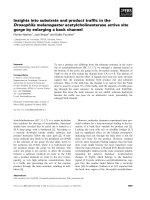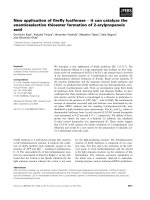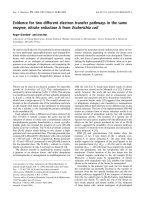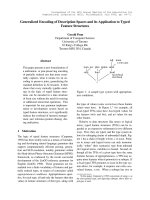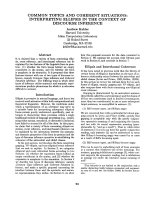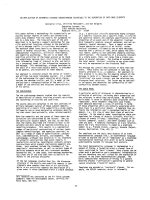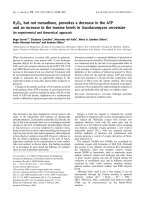báo cáo khoa học: " Successful application of technetium-99m-labeled octreotide acetate scintigraphy in the detection of ectopic adrenocorticotropin-producing bronchial carcinoid lung tumor: a case report" pot
Bạn đang xem bản rút gọn của tài liệu. Xem và tải ngay bản đầy đủ của tài liệu tại đây (787.23 KB, 4 trang )
CAS E REP O R T Open Access
Successful application of technetium-99m-labeled
octreotide acetate scintigraphy in the detection
of ectopic adrenocorticotropin-producing
bronchial carcinoid lung tumor: a case report
Armaghan Fard Esfahani
1
, Maryam Chavoshi
1
, Mohammad Hadi Noorani
1
, Mohsen Saghari
1
,
Mohammad Eftekhari
1
, Davood Beiki
1
, Babak Fallahi
1
, Majid Assadi
2*
Abstract
Introduction: The diagnostic efficacy of somatostatin receptor scintigraphy labeling with 111 indium in the
localization of tumors has been assessed in a limited number of patients with contradictory outcomes. Here, we
describe the case of a patient with an ectopic adrenocorticotropic hormone-producing bronchial carcinoid tumo r
diagnosed preoperatively using technetium-99m-labeled octreotide acetate scintigraphy.
Case presentation: A 29-year-old Asian man presented to our hospital with the typical clinical features of
Cushing’s syndrome, which he had had for a duration of 18 months. The results of a biochemical evaluation
revealed he had adrenocorticotropic hormone-dependent Cushing’s syndrome. The results of a spiral abdominal
computed tomography scan showed he had bilateral adrenal hypertrophy. A magnetic resonance image of the
patient’s brain showed he had a normal hypophysis. Whole body technetium-99m-labeled octreotide acetate
scintigraphy was performed to check for the presence of an ectopic adrenocorticotropic hormone-producing
tumor. The scan results showed a small focal increase in uptake in the lower lobe of our patient’s right lung, just
above his diaphragm. A spiral chest computed tomography scan also revealed a small non-specific lesion in the
same region. A transthoracic biopsy was then performed. Pathological evaluation confirmed the diagnosis of a
carcinoid tumor, of the adrenocorticotropic hormone-producing type. After surgical removal, the patient’s
symptoms resolved and significant clinical improvement was achieved.
Conclusions: This case report shows that technetium-99m-labeled octreotide acetate scintigraphy can effectively
detect an ectopic adrenocorticotropic hormone-producing bronchial carcinoid.
Introduction
The ectopic secretion of adrenocorticotropic hormone
(ACTH) from nonpituitary tumors causes approximately
10% cases of Cushing’ ssyndrome[1].Insomepatients,
where the presence of an ectopic tumor has been con-
sidered as the cause of Cus hing’s syndrome, localization
of the tumor has been difficult using modalities such as
computed tomography (CT) and magnetic resonance
imaging (MRI) of the patient’ s chest an d abdomen,
leaving p alliative chemical or surgical adrenalectomy as
the available treatment options [2].
Somatostatin receptor scintigraphy (SRS) using 111
indium (In)-pentetreotide and 18F-fluorodeoxyglucose
posit ron emission tomography (FDG-PET) are the func-
tional techniques currently used to detect ectopic
ACTH-secreting lesions. However, the diagnostic effi-
cacy of SRS labeling with 1 11In in the localization of
such tumors has only been assessed in a limited number
of patients, with contradictory outcomes [3].
Wedescribeacaseofapatientwithanectopic
ACTH-producing bronchial carcinoid tumor diagnosed
preoperatively using technetium-99m-labeled octreotide
acetate scintigraphy.
* Correspondence:
2
Bushehr Research Center for Nuclear Medicine, The Persian Gulf Biomedical
Sciences Institute, Bushehr University of Medical Sciences, Bushehr, Iran
Full list of author information is available at the end of the article
Esfahani et al. Journal of Medical Case Reports 2010, 4:323
/>JOURNAL OF MEDICAL
CASE REPORTS
© 2010 Esfahani et a l; licensee BioMed Central Ltd. This is an Open Access article distributed under the terms of the Creative Commons
Attribution Licens e ( which permits u nrestricted use , distribution, and reproduction in
any medium, provided the original work is properly cited.
Case presentation
A 29-year-old Asian man present ed to our hospital with
upper and lower extremity weakness, significant weight
gain (20 kg o ver 18 months), dyspnea, insomnia, early-
morning awakening, psychiatric symptoms (illusions,
impaired concentration and memory, inappropriate
laughter and crying attacks), and erectile dysfunction.
Physical examination revealed the typical clinical fea-
tures of Cushing’ s syndrome: hypotension, moon face,
buffalo hump, multiple purple striae on the flanks, prox-
imal myopathy and oral candidiasis. He was admitted to
our hospital with an initial diagnosis of hypercortisolism.
Biochemical test results confirmed the diagnosis and
revealed that he had elevated serum cortisol (8 a.m.)
and ACTH levels on multiple samplings. Dexametha-
sone suppression test results were positive on two con-
secutive samplings. His urine cortisol level was elevated,
but his vanillylmandelic acid and metanephrine levels
were normal. Other laboratory tests were noncontribu-
tory to the diagnosis.
An MRI scan of his brain found no pituitary defects,
but a spiral abdominal CT sca n revealed bilatera l adre-
nal hyperplasia. The clinical and imaging findings raised
suspicion of an ACTH-producing tumor. A broncho-
scopy and alveolar lavage was performed to investigate
the patient’s lungs, but no bronchial lesion was found.
Technetium-99m-labeled octreotide acetate scintigra-
phy was performed in the whole body planar (Figures 1
and 2) a nd single photon emission CT mode (Figure 3),
3 hours after the injection of 555MBq (15mCi) tec hne-
tium-99m-labeled octreotide acetate. The scan demon-
strated a focal uptake in the lower lobe of the patient’ s
right lung, just above his diaphragm, which was highly
suggestive of an ACTH-producing bronchial tumor.
Corresponding transverse images from a chest CT scan
showed a well-defined mass about 22 mm in d iameter in
the lower lobe of the patient’s right lung (Figure 4).
A transthoracic biopsy was performed and histopatho-
logical evaluation establi shed the diagnosis of a carci-
noid tumor of the ectopic ACTH-producing type. After
removal of the mass, the patient’ s condition improved
significantly. His clinical symptoms diminished and the
results of biochemical tests returned to normal ranges.
Discussion
Ectopic ACTH-producing tumors occur in approxi-
mately 10% of cases of patients with Cushing’ssyn-
drome. Although a biochemical diagnosis of Cushing’ s
syndrome is easily achieved , local ization of the tumor is
more difficult [1,3]. Cushing’ s disease is the cause of
Cushing’ s syndrome in 70% of cases. A bronchial
Figure 1 Technetium-99m-labeled octreotide acetate
scintigraphy in the whole body planar view. This was performed
3 hours after injection of 15mCi technetium-99m-labeled octreotide
acetate. There is a focal uptake in the lower lobe of our patient’s
right lung, just above his diaphragm, highly suggestive of an
adrenocorticotropic hormone (ACTH)-producing bronchial tumor.
Esfahani et al. Journal of Medical Case Reports 2010, 4:323
/>Page 2 of 4
carcinoid tumor is the type of ectopic ACTH-producing
lesion responsi ble in most cases [4,5]. Carcinoid tumors
are malignant neoplasms originating from neuroendo-
crine cells [6]. To investigate the exact location of such
tumors multiple imaging modalities are requir ed, and at
present no single modality can pinpoint the location of
a suspected lesion [5,7]. The diagnostic utility of In-111
technetium-99m-labeled octreotide ac etate scintigraphy
in patients with suspected lesions has been debated.
Some believe that it is not helpful [5], whereas others
have reported radionuclide imaging to be a useful diag-
nostic tool [3].
From a literature review, we found limited studies
have addressed the use of an octreotide compound with
technetium labeli ng. Although In-111-l abeled octreo tide
scint igraphy has b een shown to be a helpful tool for the
diagnosis of somatostatin-expressing tumors, and this
method has been broadly used, it has several shortcom-
ings such as high radiation dose, high cost and limited
Figure 2 Technetium-99m-labeled octreotide acetate
scintigraphy in spot abdominal view. This was performed 3 hours
after injection of 15mCi technetium-99m-labeled octreotide acetate.
There is a focal uptake in the lower lobe of our patient’s right lung, just
above his diaphragm, highly suggestive of an adrenocorticotropic
hormone (ACTH)-producing bronchial tumor.
Figure 3 Technetium-99m-labeled octreotide acetate scintigraphy performed in single photon emission computed tomography mode.
This was conducted 3 hours after injection of 15mCi technetium-99m-labeled octreotide acetate. The scan demonstrated a focal uptake in the
lower lobe of our patient’s right lung, just above his diaphragm, highly suggestive of an adrenocorticotropic hormone (ACTH)-producing
bronchial tumor.
Figure 4 Corresponding transverse images of a chest
computed tomography scan showing a well-defined mass
about 22 mm in the lower lobe of the patient’s right lung.
Esfahani et al. Journal of Medical Case Reports 2010, 4:323
/>Page 3 of 4
availability. To address these drawbacks, octreotide com-
pounds have been labeled with Tc-99m.
In one study, the diagnostic outcomes of In-111
octreotide scintigraphy and Tc-99m Hynic Toc/Tate
scintigraphy in 24 patients with different pathologies
including t wo cases o f ectopic Cushing’s disease, were
found to be identical [8].
In another investigation, the clinical value of tomo-
graphic technetium-99m-labeled octreotide acetate scin-
tigraphy was compared with
18
F-FDG dual-head
coincidence imaging (DHC) of 44 patients with sus-
pected lung tumors [9]. The sensitivity, specificity, posi-
tive predictive value, a nd negative predictive value of
technetium-99m-labeled octreotide ac etate scintigraphy
were 100%, 75.7%, 90.1%, and 100%, respectively; and
for
18
F-FDG DHC the values were 100%, 46.1%, 83.8%,
and 100%, respectively [9]. This comparison demon-
strated that tomographic technetium-99m-labeled
octreotide acetate scintigraphy had high sensitivity for
distant metastases but lower sensitivity for the detection
of hilar and m ediastinal lymph node metastasis as com-
pared with
18
F-FDG DHC coincidence PET [9].
Our case report shows the usefulness of technetium-
99m-labeled octreotide acetate scintigraphy in the locali-
zation of ectopic ACTH-secreting tumors in patients
biochemically and clinically diagnosed with Cushing’s
syndrome. However, further well-designed studies to
evaluate its efficacy are required.
Conclusions
Our case report shows that technetium-99m-labeled
octreotide acetate scintigraphy can effectively detect an
ectopic ACTH-producing bronchial carcinoid.
Consent
Written informed consent was obtained from the patient
for publication of this case report and any accompany-
ing images. A copy of the written consent is available
for review by the Editor-in-Chief of this journal.
Acknowledgements
We are indebted to the technologists at our department for data acquisition
and other technical support.
Author details
1
Research Institute for Nuclear Medicine, Shariati Hospital, Tehran University
of Medical Sciences, Tehran, Iran.
2
Bushehr Research Center for Nuclear
Medicine, The Persian Gulf Biomedical Sciences Institute, Bushehr University
of Medical Sciences, Bushehr, Iran.
Authors’ contributions
AFE participated in the design and coordination of the study, drafting the
manuscript and interpreting the radiological figures. MC participated in the
design and coordination of the study, drafting the manuscript and
interpreting the radiological figures. MHN participated in the design and
coordination of the study, drafting the manuscript and interpreting the
radiological figures. MS supervised the acquisition and interpretation of the
radiological images. ME supervised the acquisition and interpretation of the
radiological images. DB supervised the acquisition and interpre tation of the
radiological images. BF supervised the acquisition and interpretation of the
radiological images. MA revised the article for important intellectual content
and helped draft the manuscript. All authors read and approved the final
manuscript.
Competing interests
The authors declare that they have no competing interests.
Received: 30 December 2009 Accepted: 18 October 2010
Published: 18 October 2010
References
1. Ilias I, Torpy DJ, Pacak K, Mullen N, Wesley RA, Nieman LK: Cushing’s
syndrome due to ectopic corticotropin secretion: twenty years’
experience at the National Institutes of Health. J Clin Endocrinol Metab
2005, 90:4955-4962.
2. Matte J, Roufosse F, Rocmans P, Schoutens A, Jacobovitz D, Mockel J:
Ectopic Cushing’s syndrome and pulmonary carcinoid tumour identified
by [111In-DTPA-D-Phe1]octreotide. Postgrad Med J 1998, 74:108-110.
3. Tsagarakis S, Christoforaki M, Giannopoulou H, Rondogianni F,
Housianakou I, Malagari C, Rontogianni D, Bellenis I, Thalassinos N: A
reappraisal of the utility of somatostatin receptor scintigraphy in
patients with ectopic adrenocorticotropin Cushing’s syndrome. J Clin
Endocrinol Metab 2003, 88:4754-4758.
4. Weiss M, Yellin A, Husza’r M, Eisenstein Z, Bar-Ziv J, Krausz Y: Localization of
adrenocorticotropic hormone-secreting bronchial carcinoid tumor by
somatostatin-receptor scintigraphy. Ann Intern Med 1994, 121:198-199.
5. Isidori AM, Kaltsas GA, Pozza C, Frajese V, Newell-Price J, Reznek RH,
Jenkins PJ, Monson JP, Grossman AB, Besser GM: The ectopic
adrenocorticotropin syndrome: clinical features, diagnosis, management,
and long-term follow-up. J Clin Endocrinol Metab 2006, 91:371-377.
6. Shrager JB, Wright CD, Wain JC, Torchiana DF, Grillo HC, Mathisen DJ:
Bronchopulmonary carcinoid tumors associated with Cushing’s
syndrome: a more aggressive variant of typical carcinoid. J Thorac
Cardiovasc Surg 1997, 114:367-375.
7. Grossman AB, Kelly P, Rockall A, Bhattacharya S, McNicol A, Barwick T:
Cushing’s syndrome caused by an occult source: difficulties in diagnosis
and management. Nat Clin Pract Endocrinol Metab 2006, 2:642-647.
8. Kabasakal L, Sager S, Yilmaz S, Ocak M, Altiparmak M, Deldag M, Maecke H,
Onsel C, Uslu I: Comparison of In-111 octreotide scintigraphy with Tc-
99m Hynic Toc/Tate scintigraphy in the same patient group for
diagnosis of somatostatin receptor expressing tumors. J Nucl Med 2006,
47(Suppl 1):442.
9. Wang F, Wang Z, Yao W, Xie H, Xu J, Tian L: Role of 99mTc-octreotide
acetate scintigraphy in suspected lung cancer compared with 18F-FDG
dual-head coincidence imaging. J Nucl Med 2007, 48:1442-1448.
doi:10.1186/1752-1947-4-323
Cite this article as: Esfahani et al.: Successful application of technetium-
99m-labeled octreotide acetate scintigraphy in the detection of ectopic
adrenocorticotropin-producing bronchial carcinoid lung tumor: a case
report. Journal of Medical Case Reports 2010 4:323.
Submit your next manuscript to BioMed Central
and take full advantage of:
• Convenient online submission
• Thorough peer review
• No space constraints or color figure charges
• Immediate publication on acceptance
• Inclusion in PubMed, CAS, Scopus and Google Scholar
• Research which is freely available for redistribution
Submit your manuscript at
www.biomedcentral.com/submit
Esfahani et al. Journal of Medical Case Reports 2010, 4:323
/>Page 4 of 4


